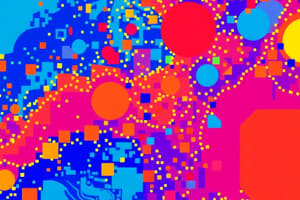Podcast
Questions and Answers
Explain the relationship between the respiratory and circulatory systems in delivering oxygen to cells and removing carbon dioxide.
Explain the relationship between the respiratory and circulatory systems in delivering oxygen to cells and removing carbon dioxide.
The respiratory system takes in oxygen, which is then absorbed into the blood. The circulatory system transports this oxygen-rich blood to the body's cells. Simultaneously, the circulatory system carries carbon dioxide, a waste product from the cells, to the lungs, where the respiratory system expels it.
How does the excretory system contribute to maintaining the balance of substances in the blood?
How does the excretory system contribute to maintaining the balance of substances in the blood?
The excretory system filters the blood to remove waste products, excess salts, and other substances. By adjusting the levels of these components, it maintains the appropriate concentration of various substances in the blood, contributing to overall homeostasis.
Describe the role of the liver in excretion. How do the products of the Liver get eliminated from the body?
Describe the role of the liver in excretion. How do the products of the Liver get eliminated from the body?
The liver processes and eliminates toxic pigments produced when red blood cells die, secreting them, along with bile, into the intestine for removal via feces.
How might significant damage to the kidneys affect other systems in the body?
How might significant damage to the kidneys affect other systems in the body?
What are transgenic foods and what are some of their characteristics?
What are transgenic foods and what are some of their characteristics?
Explain how the structure of arteries differs from that of veins and relate this difference to their respective functions.
Explain how the structure of arteries differs from that of veins and relate this difference to their respective functions.
Describe the process of how the urinary system produces urine.
Describe the process of how the urinary system produces urine.
How would you differentiate between natural, ultra-processed, and transgenic foods?
How would you differentiate between natural, ultra-processed, and transgenic foods?
If a person experiences a significant decrease in their red blood cell count, how would that affect the circulatory system's function?
If a person experiences a significant decrease in their red blood cell count, how would that affect the circulatory system's function?
How does sweating assist the body in excretion and thermoregulation?
How does sweating assist the body in excretion and thermoregulation?
Flashcards
Excretion
Excretion
Excretion is the process by which waste substances produced by the body are eliminated.
Lungs excretion
Lungs excretion
Lungs eliminate carbon dioxide and water produced by cells during energy production, when glucose reacts with oxygen.
Skin excretion
Skin excretion
The skin eliminates sweat, containing ammonia, urea, and mineral salts, which gives it a salty taste. Sweat absorbs body heat, cooling the body.
Liver excretion
Liver excretion
Signup and view all the flashcards
Urinary system excretion
Urinary system excretion
Signup and view all the flashcards
Circulatory system
Circulatory system
Signup and view all the flashcards
Respiratory system
Respiratory system
Signup and view all the flashcards
Digestive system
Digestive system
Signup and view all the flashcards
Study Notes
- Matplotlib is a Python library used extensively for creating visualizations.
- It supports static, animated, and interactive plots.
- Matplotlib simplifies common visualization tasks while still enabling complex customizations.
- Plots can be generated in publication quality.
- Matplotlib has interactive figures with zoom, pan, and update capabilities.
- Highly customizable visual styles and layouts.
- Figures can be exported to various file formats.
- Figures are compatible with JupyterLab and graphical user interfaces.
- Matplotlib is the foundation for numerous third-party packages.
Installation
- To install Matplotlib using PyPI, use
pip install matplotlib. - To install using Conda, use
conda install -c conda-forge matplotlib.
Anatomy of a Plot
- Components include figure, axes, axis, ticks, labels, and the plot itself.
Pyplot Tutorial
- Import
matplotlib.pyplotaspltandnumpyasnp. - Prepare data using NumPy, such as
x = np.linspace(0, 2, 100). - Use
plt.plot()to plot data, including labels for each line. - Add labels for the x and y axes using
plt.xlabel()andplt.ylabel(). - Set a title using
plt.title(). - Display a legend with
plt.legend(). - Output the plot using
plt.show().
Key Plot Elements
- A legend describes the elements of the plot.
- A title provides a description for the plot.
- Axes are the lines that delimit the data area in the plot.
- An axis indicates the data scale.
- Ticks mark specific points on the axis at defined intervals.
- A label provides descriptive text for the data represented in the plot.
- The plot component is the graphical representation of the data itself.
Studying That Suits You
Use AI to generate personalized quizzes and flashcards to suit your learning preferences.




